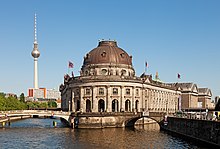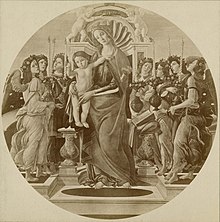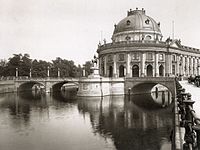Bode Museum
 | |
 | |
Former name | Kaiser-Friedrich-Museum |
|---|---|
| Established | 1904 |
| Location | Museum Island, Berlin |
| Coordinates | 52°31′19″N 13°23′41″E / 52.52194°N 13.39472°E |
| Type | Art museum |
| Website | smb.museum |
| Part of | Museumsinsel (Museum Island), Berlin |
| Criteria | Cultural: ii, iv |
| Reference | 896 |
| Inscription | 1999 (23rd Session) |
| Area | 8.6 ha (21 acres) |
| Buffer zone | 22.5 ha (56 acres) |
The Bode Museum, formerly called the Kaiser-Friedrich-Museum (Emperor Frederick Museum), is a
History and collections
Originally called the Kaiser-Friedrich-Museum after Emperor Frederick III, the museum was renamed in honor of its first curator, Wilhelm von Bode, in 1956.[citation needed]
During World War II, portions of the collection were stored in an antiaircraft tower called the Flakturm Friedrichshain for safe keeping. In May 1945, several fires destroyed some of the collections. In total, more than 400 paintings and about 300 sculptures were missing due to looting during the fire or destroyed in the fire itself.[4]
Closed for repairs since 1997, the museum was reopened on 18 October 2006, after a €156 million refurbishment.[5] True to the ethos of its founding director, Wilhelm von Bode, who believed in mixing art collections,[6] it is now the home for a collection of sculptures, Byzantine art, and coins and medals.[7] The presentation of the collections is both geographic and chronological, with the Byzantine and Gothic art of northern and southern Europe displayed separately on the museum's first floor and a similar regional division of Renaissance and Baroque art on its second floor.[6]

The sculpture collection displays artwork of the
The Münzkabinett ("coin cabinet") is one of the world's largest
Writing in
Canadian gold coin theft

On 27 March 2017, a solid gold coin called the Big Maple Leaf, issued by the Royal Canadian Mint in 2007 as a commemorative piece, was stolen from the museum.[8][9] The coin, at 50 cm in diameter and 2.8 cm in thickness, is made of 24-karat gold and is worth around €3.7 million.[10] A ladder was found on the train tracks nearby, leading German police to speculate that the thief entered the building by breaking open a window in the back of the museum next to the railway tracks.[8][10]
The thieves were later found to be 21 and 23-year-old cousins Ahmed and Wissam Remmo, along with their friend, Denis W.[11] Police do not expect to ever recover the coin, as the presence of gold dust leads them to believe the culprits had melted it down. Ahmed's brother Wayci was also charged, but later acquitted.
See also
Gallery
-
At night
-
The entrance hall
-
The cupola
-
Byzantine collection
-
Trecento room
-
Museum Island with Pergamon Museum and Bode Museum (1951)
-
Bode-Museum, Berlin von der Spree.
-
View from the Bode Museum bridge on to the river
-
The Bode Museum, part of the ensemble of Berlin Museums located on the UNESCO listed Museum Island
References
- ^ Bodemuseum (Kaiser-Friedrich-Museum)(in German) Landesdenkmalamt Berlin Archived 18 July 2020 at the Wayback Machine
- ^ "Staatliche Museen zu Berlin: Home". Staatliche Museen zu Berlin. Retrieved 29 January 2023.
- ^ "Museumsinsel (Museum Island), Berlin". UNESCO World Heritage Centre. United Nations Educational Scientific and Cultural Organization. Retrieved 30 July 2022.
- ^ "Beauty, Fire, & Memory: Lost Art of the Kaiser-Friedrich-Museum". National Gallery of Art Department of Image Collections. Archived from the original on 24 October 2020. Retrieved 19 November 2021.
- ^ "Teuer, billig, im Plan: Berliner Kulturbauten und was sie kosten". Der Tagesspiegel. 17 October 2013.
- ^ ISSN 0362-4331. Retrieved 29 January 2023.
- ^ "Sculpture Collection and Museum of Byzantine Art". Staatliche Museen zu Berlin. Archived from the original on 15 September 2012.
- ^ a b "Solid gold coin worth $4m stolen from Berlin museum". BBC News. 27 March 2017. Retrieved 27 March 2017.
- ^ Dowling, Tim (28 March 2017). "Forging pound coins? That's not a crime – it's a job". the Guardian. Retrieved 10 April 2022.
- ^ a b Hall, Melanie (28 March 2017). "Giant gold coin worth almost €4 million stolen from Berlin museum in dawn heist". The Telegraph. Retrieved 27 March 2017.
- ^ Dafoe, Taylor (21 February 2020). "The Bumbling Thieves Who Stole an Enormous $4.3 Million Gold Coin From a Berlin Museum—and Probably Melted It Down—Are Heading to Prison". Artnet News.
External links
- Official website (in English and German)
- Sculpture Collection and Museum of Byzantine Art
- Virtual Tour Through 35 Rooms (Sculpture Collection and Byzantine Art)
- Numismatic Collection
- Virtual Tour Through Numismatic Collection (with Gateway to Online Catalogue) Archived 6 September 2015 at the Wayback Machine










